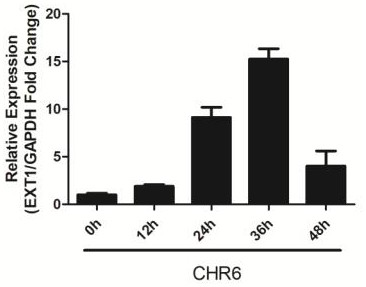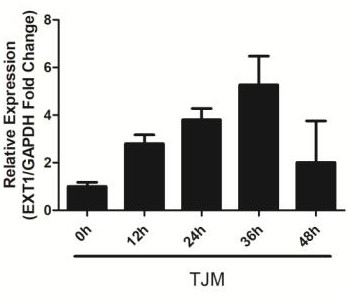A method for screening pigs resistant to PRRS based on the expression level of ext1
A PRRSV expression technology, applied in the field of biomedicine, can solve problems such as increased virulence, difficulty in preventing and controlling PRRSV, and damage to the immune system of the body
- Summary
- Abstract
- Description
- Claims
- Application Information
AI Technical Summary
Problems solved by technology
Method used
Image
Examples
Embodiment 1
[0047] Example 1 Research on EXT1 gene regulating PRRSV replication in vitro
[0048] Marc-145 cells were cultured in DMEM medium containing 10% fetal bovine serum, and inoculated with three different strains of PRRSV (CHR6, TJM, PRRSV-EGFP) at MOI=0.1, in DMEM medium containing 2% fetal bovine serum Continue to culture at 37°C, collect cells at different time points, and perform Western-blot detection on the EXT1 gene. The results are as follows: figure 1 As shown, after PRRSV infected Marc-145 cells, the expression of EXT1 protein was significantly increased. qRT-PCR detection of EXT1 gene, the results are as follows figure 2 , 3 As shown in , 4, after three different strains of PRRSV (CHR6, TJM, PRRSV-EGFP) infected Marc-145 cells, the expression of EXT1 mRNA was significantly increased.
Embodiment 2
[0049] Embodiment 2 EXT1 interference
[0050] 1. Send the designed EXT1 siRNA and 1 pair of Negative Control (control) to Thermo Fisher Scientific for synthesis, and use Lipofectamine™ RNAiMAX transfection reagent (purchased from Thermo Fisher Scientific). Culture Marc-145 cells to 60-70% density in 2 6-well plates with DMEM medium containing 10% fetal bovine serum, and respectively mix siRNA (3 pairs of siRNA and 1 control) and Lipofectamine™ RNAiMAX with Opti-MEM ®Reduced Serum Medium diluted, mixed at a ratio of 1:1 after dilution and incubated at room temperature for 5 minutes, then added to Marc-145 cells replaced with fresh DMEM medium and incubated in a 37°C, 5% CO2 incubator for 6 hours, discarded After washing once with PBS, the cells were cultured in DMEM containing 10% fetal bovine serum for 48 h, and the cells were collected to verify the interference effect of EXT1 by qRT-PCR. After another 6-well plate was cultured for 48 h, PRRSV was added to the culture mediu...
Embodiment 3
[0054] Example 3 EXT1 overexpression
[0055] 1. Construct pcDNA3.1-EXT1 overexpression vector, culture Marc-145 cells to 60-70% density with DMEM medium containing 10% fetal bovine serum in two 6-well plates, use Lipofectamine™ 2000 (purchased from Thermo Fisher Scientific) respectively transferred pcDNA3.1-EXT1 and pcDNA3.1 empty vectors into Marc-145 cells, cultured in a 37°C, 5% CO2 incubator for 6 h, discarded the supernatant, washed once with PBS, and washed with 10% The DMEM medium of fetal bovine serum was cultured for 24 h, and the cells were collected to detect the effect of overexpression. After another 6-well plate was cultured for 24 hours, PRRSV was added to the culture medium, and then cultured for 36 and 48 hours, and the cells were collected to detect the effect of EXT1 overexpression on PRRSV replication.
[0056] 2. The result is as follows Figure 9 As shown, after EXT1 overexpression, EXT1 mRNA was significantly increased. EXT1 is a heparan sulfate HS s...
PUM
 Login to View More
Login to View More Abstract
Description
Claims
Application Information
 Login to View More
Login to View More - R&D
- Intellectual Property
- Life Sciences
- Materials
- Tech Scout
- Unparalleled Data Quality
- Higher Quality Content
- 60% Fewer Hallucinations
Browse by: Latest US Patents, China's latest patents, Technical Efficacy Thesaurus, Application Domain, Technology Topic, Popular Technical Reports.
© 2025 PatSnap. All rights reserved.Legal|Privacy policy|Modern Slavery Act Transparency Statement|Sitemap|About US| Contact US: help@patsnap.com



